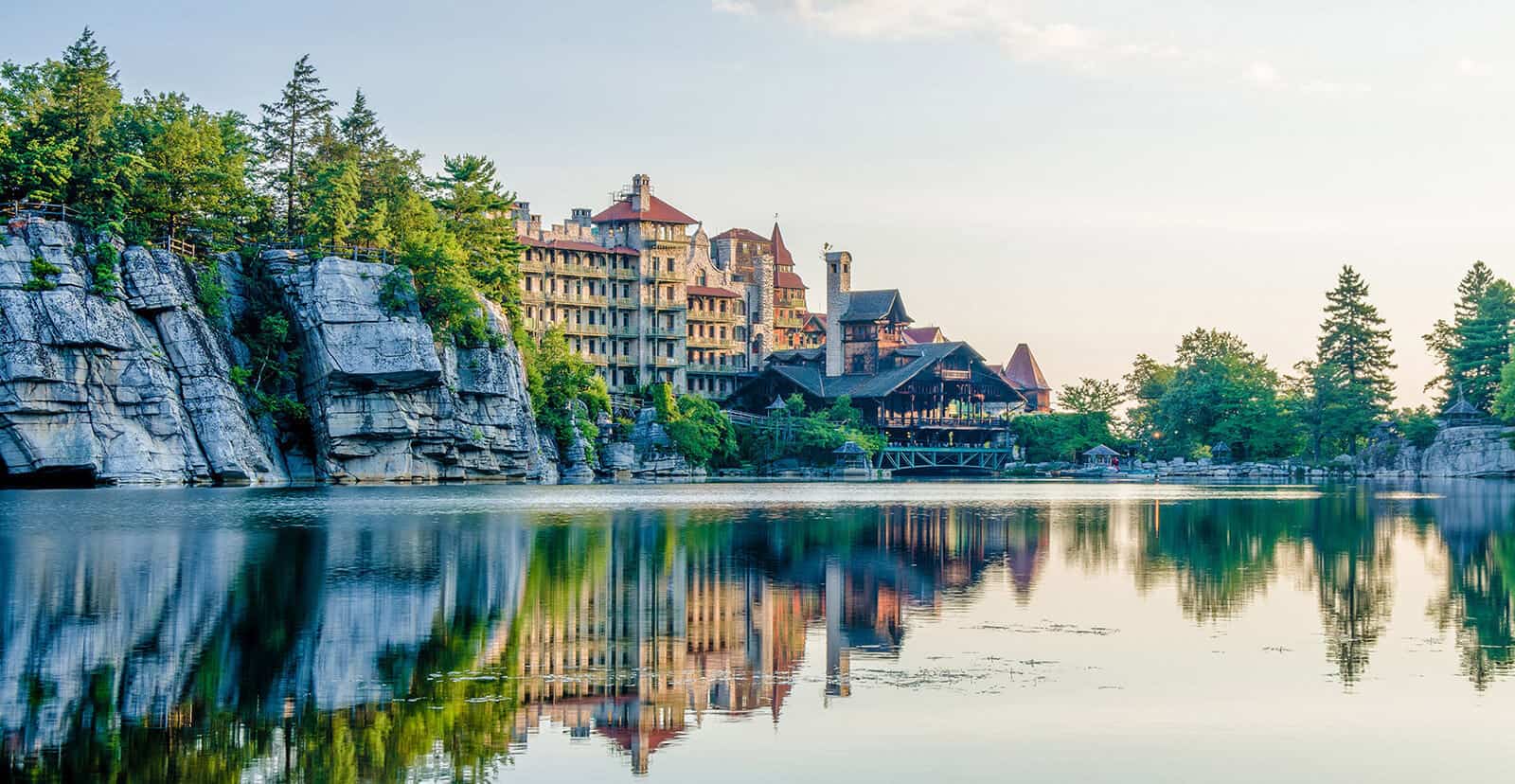In the remote expanse of Antarctica, where the cold winds howl, and the landscape is untouched by human intervention, there stands a marvel of modern engineering: the $150 million “Halley VI” research station. For decades, this cutting-edge facility has been at the forefront of scientific exploration in one of the most inhospitable environments on Earth. Its unique design, mobility, and unwavering commitment to pursuing knowledge have made it a symbol of human ingenuity.
But what if I told you that now, you have a chance to be part of this remarkable journey? In an unprecedented move, Halley VI is opening its doors to private individuals, offering them the opportunity to experience the grandeur of Antarctica like never before. Imagine sleeping in the heart of this frozen wilderness, dining amidst the icy landscape, and partaking in activities that will etch memories for a lifetime.
This article delves into the fascinating world of the Halley VI research station, where science and luxury converge. We’ll explore the station’s history, innovative design, and pivotal role in Antarctic research. Additionally, we’ll discuss the concept of private hire, who gets to access this pristine environment, and the ethical and environmental considerations that come with this unique opportunity.
So, if you’ve ever dreamt of standing on the frozen continent beneath the shimmering Aurora Australis and experiencing the true essence of Antarctica, then read on. The journey begins here as we unveil the $150 million “Halley VI” research station’s doors to a select few who seek adventure, luxury, and the unparalleled beauty of this southernmost continent.
The Halley VI Research Station: A Marvel of Antarctic Architecture
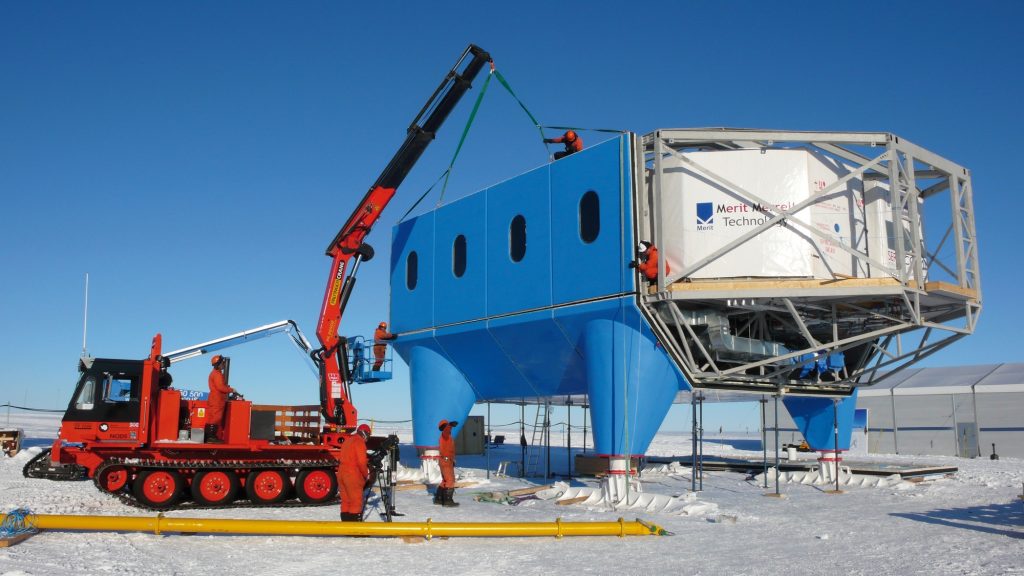
Nestled amidst Antarctica’s harsh and desolate landscape, the Halley VI Research Station stands as a testament to human ingenuity and resilience. This research station is a marvel of architecture and engineering in the unforgiving environment of the southernmost continent, where temperatures can plummet to bone-chilling lows, and isolation reigns supreme.
A Brief History of the Halley Research Stations
The story of the Halley Research Stations is a tale of scientific innovation and human perseverance in one of the world’s harshest and most desolate environments. These research stations, named after the 17th-century astronomer Edmond Halley, are a testament to the enduring spirit of Antarctic exploration.
The Legacy of Edmond Halley
Before delving into the modern history of the Halley Research Stations, paying homage to their namesake, Edmond Halley, is fitting. The English astronomer and mathematician is best known for calculating the orbit of the famous Halley’s Comet, which returns to Earth’s vicinity approximately every 76 years. His groundbreaking work in the late 17th century set the stage for future astronomical discoveries.
The Birth of Halley Research Stations
The origins of the Halley Research Stations can be traced back to the International Geophysical Year (IGY) of 1957–1958. During this global effort to enhance our understanding of the Earth’s natural processes, the British Antarctic Survey (BAS) established the first Halley Station, aptly named “Halley I.”
Halley I, constructed on the Brunt Ice Shelf, was a relatively modest affair, serving as a crucial base for meteorological and geomagnetic research. The station’s dedication to scientific discovery set the precedent for what was to come.
The Resilience of Halley II and Halley III
Antarctica’s significance in climate science grew, as did the need for more sophisticated research facilities. In 1967, Halley II, a more capable station built to withstand the harsh Antarctic conditions, eventually took the place of the original Halley I. Halley II, however, faced a unique challenge when a rift in the Brunt Ice Shelf threatened its stability. 1984, the station was towed 14 miles inland to a safer location.
This marked the beginning of a remarkable legacy for the Halley Research Stations: their ability to adapt and endure. Halley III, constructed on the relocated site of Halley II, continued to push the boundaries of scientific research.
The Innovative Design of Halley VI
In 2012, the world witnessed the birth of the most advanced Halley station, Halley VI. Halley VI’s innovative design and mobility set it apart from its predecessors. Halley VI can be towed across the ice, comprising eight interconnected modules, ensuring it remains on a floating ice platform rather than becoming adrift on an iceberg.
This mobility is crucial, as the ice shelf beneath Halley VI is constantly in flux. By moving with the ice, the station avoids drifting into the sea. Halley VI’s design protects it and allows for a modular approach to scientific research, accommodating a range of disciplines under one roof.
Halley VI’s Ongoing Contribution to Science
Over the years, the Halley Research Stations have been instrumental in various scientific endeavors. The stations have provided valuable insights into our planet’s complex systems, from climate monitoring and atmospheric research to studying the Earth’s magnetic field and its interaction with solar winds.
In recent years, Halley VI has been at the forefront of climate change research, particularly in monitoring the dramatic shifts occurring in the Antarctic ice. Its location allows for continuous observation of the impacts of climate change on this vulnerable region.
The Halley Research Stations represent a testament to human ingenuity and determination and a crucial hub for understanding the mysteries of Antarctica and the Earth’s natural processes. From their modest beginnings during the IGY to the groundbreaking design of Halley VI, these research stations continue to make significant contributions to science, safeguarding their place in the annals of Antarctic exploration.
The Unique Design and Mobility of Halley VI
In the remote and unforgiving landscapes of Antarctica, where the elements are harsh and unpredictable, the design and mobility of research stations are of paramount importance. Enter Halley VI, a research station like no other, which redefines what it means to thrive in one of the harshest environments on Earth.
The Ingenious Blueprint
The Halley VI research station, part of the British Antarctic Survey’s (BAS) legacy of research facilities, is celebrated for its ingenious and innovative design. Unlike traditional fixed Antarctic research stations, Halley VI is modular and mobile, making it an exceptional feat of engineering.
Modularity: The Key to Adaptation
The station comprises eight interlinked modules, each serving a unique purpose, from accommodation to laboratories and storage. This modularity offers immense flexibility. Scientists can adjust the station’s configuration to suit their research needs, providing a space tailored for various scientific disciplines.
Mobility: A Moving Research Platform
One of the most remarkable aspects of Halley VI’s design is its ability to move. This mobility ensures that the station remains atop the Brunt Ice Shelf rather than risking detachment and becoming adrift on a drifting iceberg. This fate befell its predecessor, Halley V.
Halley VI’s modules are built on skis, allowing the station to be towed across the ice. This mobility is critical because the Brunt Ice Shelf is constantly changing beneath which the station is located. The station’s ability to relocate prevents it from being stranded on an ice island, which would significantly hamper research efforts.
A Mobile Oasis in the Frozen Desert
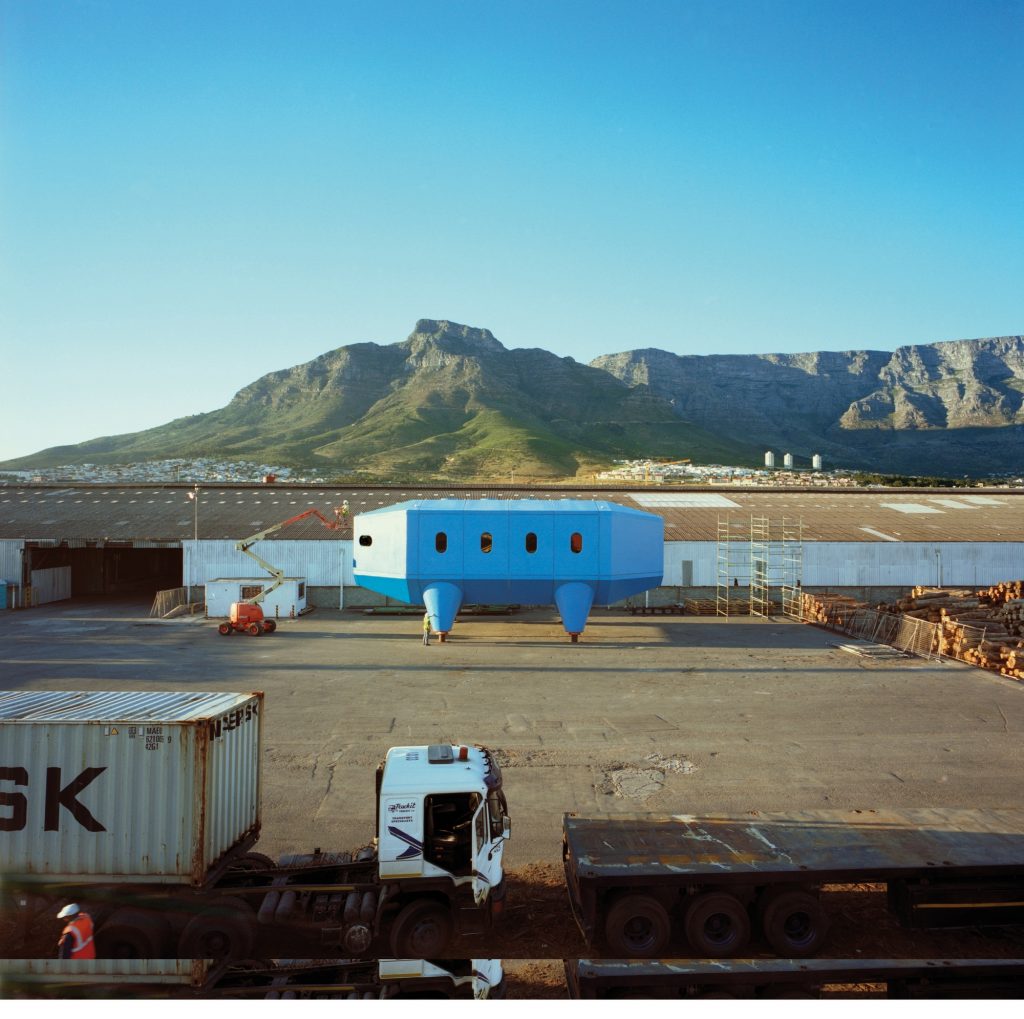
The mobility of Halley VI is more than just a practical necessity; it’s a lifeline for the station’s occupants. In the ever-changing Antarctic environment, where ice can fracture and crevasses can form suddenly, mobility ensures the safety of the researchers and staff who call Halley VI home during the harsh Antarctic winters.
Surviving in the Extremes
Antarctica is synonymous with extreme conditions. In the heart of winter, the continent plunges into darkness, and temperatures can drop to bone-chilling lows. Halley VI’s design takes these challenges into account. The station is constructed to withstand winds of up to 90 miles per hour, providing a secure haven for those inside.
Environmental Considerations
In addition to its functionality, Halley VI’s design is also environmentally conscious. It is equipped with systems for waste management, power generation, and efficient use of resources. Sustainability is a core principle in its operation, reflecting the commitment to preserving the fragile Antarctic ecosystem.
The Promise of Ongoing Research
The unique design and mobility of Halley VI have made it a beacon of scientific progress in the Antarctic. The ability to shift the station to follow the movement of the ice shelf is vital for climate monitoring, especially when the continent is experiencing significant changes due to global warming.
Halley VI is at the forefront of climate change research, providing essential data for understanding the dynamics of Antarctic ice and its response to environmental shifts. As we grapple with the profound implications of climate change, the research conducted at Halley VI is more critical than ever.
The unique design and mobility of Halley VI are a testament to human innovation and adaptability in one of the most challenging environments on Earth. This mobile research station not only pushes the boundaries of scientific exploration but also safeguards the safety of its inhabitants, ensuring that its vital work continues, even in the face of the harshest conditions Antarctica has to offer.
Halley VI’s Role in Antarctic Research
With its exceptional design and mobility, Halley VI is a key player in Antarctic research. The station’s unique features make it an architectural marvel and an invaluable hub for scientific discovery in one of the most extreme environments on Earth.
A Window to the Changing Antarctic Landscape
One of the primary roles of Halley VI is to serve as a sentinel in a rapidly evolving Antarctic landscape. With its strategic location on the Brunt Ice Shelf, the station offers scientists an unprecedented opportunity to monitor and research the effects of climate change in real time.
Tracking Ice Dynamics
The Brunt Ice Shelf is in constant flux, with rifts and cracks appearing as the ice sheet shifts. Halley VI is equipped with specialized instruments to study these changes, providing critical data on the dynamics of the Antarctic ice.
Insights into Climate Change
This station’s location has made it a focal point for climate change research. The data collected at Halley VI helps scientists understand the repercussions of global warming on the Antarctic region, including rising sea levels and the effects on marine ecosystems.
A Multidisciplinary Research Hub
Halley VI is not confined to a single scientific discipline. Instead, it is a multidisciplinary research hub where scientists from various fields collaborate to gain a more comprehensive understanding of Antarctica’s unique environment.
Atmospheric and Meteorological Research
The station hosts numerous instruments for monitoring the Earth’s atmosphere and weather patterns. These measurements are vital for climate studies and weather forecasting, both regionally and globally.
Geomagnetic and Space Science
Researchers at Halley VI conduct geomagnetic and space science experiments. These studies provide insights into the Earth’s magnetic field, solar activity, and cosmic ray interactions in the Antarctic region.
Biological Studies
Antarctica’s extreme conditions, from the sub-zero temperatures to the isolation, make it an ideal location for biological research. Scientists at Halley VI study the unique adaptations of life forms in this frigid environment.
Seismological Studies
The station is also equipped with seismological instruments to monitor seismic activity, providing data for understanding the tectonic processes beneath the continent.
Pioneering Climate Solutions
Halley VI’s role in Antarctic research extends beyond data collection; it actively contributes to pioneering climate solutions. The station operates under stringent environmental principles, minimizing its ecological footprint. Its waste management systems, renewable energy sources, and resource-efficient designs exemplify its commitment to sustainability.
A Platform for International Collaboration
Halley VI is not an isolated research station; it is part of a network of global scientific collaborations. Researchers from various countries work together at this station to share knowledge and resources, emphasizing the international effort to understand and address the challenges posed by climate change.
Halley VI’s significance in Antarctic research cannot be overstated. Its unique design and mobility have made it a vanguard in climate studies, providing valuable insights into the changing Antarctic landscape. As climate change continues to shape our world, this research station’s role in monitoring and understanding its impacts remains vital in our quest for a sustainable future.
Opening Antarctica’s Doors: The Idea of Private Hire
Breaking New Ground: The Concept of Private Expeditions
In the heart of the frozen continent of Antarctica, where frigid temperatures, biting winds, and vast stretches of ice define the landscape, a novel concept is emerging. It’s a concept that challenges traditional notions of exploration and opens the doors of one of the most pristine and untouched environments on Earth to a select few: the idea of private expeditions to Antarctica.
The Historical Context
Antarctica has been the domain of scientific research for decades, primarily focusing on climate studies, environmental conservation, and understanding the Earth’s natural processes. The region’s harsh conditions and ecological fragility have largely limited human presence to researchers and support staff.
The 1959-signed and 1961-effective Antarctic Treaty is the basis for Antarctica’s governance. The treaty designates Antarctica as a zone of international cooperation, primarily for scientific research and environmental protection.
The Emergence of Private Expeditions
The notion of private individuals embarking on expeditions to Antarctica is relatively new but has been gaining traction in recent years. It marks a shift from exclusively scientific and government-focused exploration to a more inclusive approach, inviting adventure-seekers and those deeply appreciating the Earth’s last great wilderness.
A Blend of Adventure and Luxury
Private expeditions to Antarctica offer a unique blend of adventure and luxury. Participants can experience Antarctica’s breathtaking landscapes, magnificent wildlife, and serene isolation. Accommodations, dining, and activities are curated to ensure a comfortable and unforgettable journey.
A Range of Antarctic Experiences
Private expeditions are not a one-size-fits-all concept. They can vary widely, catering to diverse interests. Whether it’s exploring the wildlife, visiting historical sites, or even partaking in scientific research activities, these expeditions provide a customized experience for participants.
Who can Access Antarctica Privately?
The question of who can access Antarctica privately is of paramount importance. It’s not an open invitation for anyone with the means to participate. Access is typically granted to those committed to responsible and sustainable tourism and those who appreciate the significance of this pristine environment.
Environmental and Ethical Considerations
While private expeditions open up new possibilities for experiencing Antarctica, they also have significant ethical and environmental responsibilities. The fragility of the Antarctic ecosystem demands that visitors adhere to strict guidelines to minimize their environmental impact.
Sustainability and Conservation
Responsible private expeditions prioritize sustainability and conservation. They minimize waste, use renewable energy sources, and adhere to strict waste management practices. The goal is to ensure that the delicate Antarctic ecosystem remains undisturbed.
Ethics of Adventure Tourism
Balancing the adventure of exploration with the need for responsible and ethical tourism is a constant challenge. Private expedition organizers work diligently to ensure that participants respect the environment, wildlife, and historical sites they encounter.
The concept of private expeditions to Antarctica is breaking new ground in adventure and exploration. It offers an unprecedented opportunity for individuals to experience the beauty and isolation of the southernmost continent. However, with this privilege comes the responsibility to uphold the principles of sustainability and ethics, ensuring that Antarctica remains an untouched haven for generations. As private expeditions continue to grow in popularity, striking the right balance between adventure and responsibility is paramount for preserving this unique and fragile environment.
Inside the Halley VI: A Glimpse into Antarctic Luxury
Accommodations and Facilities for Guests
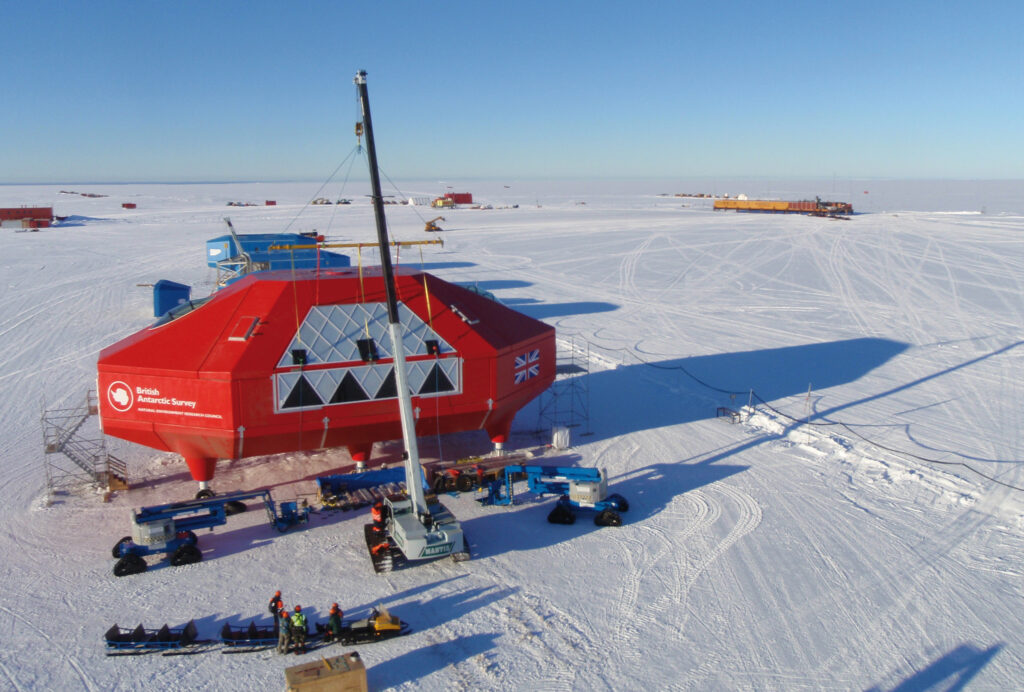
In the heart of the world’s most desolate and inhospitable continent, where temperatures can plummet to -80°F and winds can reach hurricane force, there stands a remarkable haven known as the Halley VI Research Station. While it primarily serves as a hub for scientific research, it also opens its doors to a select group of guests, providing them with exceptional accommodations and facilities.
The Oasis in Antarctica
Accommodations at Halley VI are a far cry from what one might typically associate with Antarctic exploration. Instead of frigid tents and Spartan living conditions, guests are welcomed into a warm and inviting environment designed to provide comfort and safety in one of the harshest places on Earth.
The Sleeping Quarters
Guests stay in comfortable and heated sleeping pods. These pods offer a cozy and insulated space, with sleeping bags and warm blankets to ensure a good night’s rest even in the extreme cold. While you may be sleeping in Antarctica, you won’t feel like you are.
Dining with a View
One of the highlights of the guest facilities at Halley VI is the dining area. Here, visitors can eat various delectable meals that expert chefs frequently prepare. The large windows offer stunning views of the Antarctic landscape, making every meal a unique experience. Dining at Halley VI is about more than nourishment; it’s about savoring the majesty of the frozen wilderness.
Social Spaces
Halley VI boasts common areas that allow guests to relax, socialize, and enjoy their time at the station. These spaces are designed to create a sense of community among guests, fostering conversations and connections amid the Antarctic beauty.
Communication Hub
While you might be far from civilization, Halley VI ensures that you can remain connected with the world. The station is equipped with communication facilities, allowing guests to maintain contact with loved ones or share their incredible journey with the rest of the world.
Experiencing the Antarctic Wilderness
Accommodations at Halley VI are just the beginning. The station also offers a range of activities and facilities to ensure that guests can make the most of their Antarctic adventure.
Guided Tours
One of the highlights of a stay at Halley VI is the guided tour. Experienced guides take guests on excursions to explore the stunning Antarctic scenery. Whether visiting penguin colonies or observing the otherworldly beauty of ice formations, these tours provide an up-close encounter with the pristine landscape.
Scientific Engagement
For those with a keen interest in science, Halley VI offers opportunities to engage with ongoing research projects. From atmospheric studies to wildlife observation, guests can actively participate and learn from the ongoing scientific work.
Relaxation and Recreation
The station also provides spaces for relaxation and recreation, including libraries, exercise areas, and even a small cinema. These facilities offer opportunities to unwind and recharge, whether you prefer reading, working out, or enjoying a movie night in Antarctica.
Ethical and Environmental Considerations
While the accommodations and facilities at Halley VI offer a luxurious and immersive Antarctic experience, they do so with the utmost care for the environment. Sustainability and conservation are paramount, and the station is committed to minimizing its impact on the delicate Antarctic ecosystem.
Accommodations and facilities at Halley VI are a testament to the human capacity to adapt and thrive in the most challenging environments. Guests at this remarkable research station can expect comfort and safety and the opportunity to connect with the pristine beauty of Antarctica and engage with ongoing scientific endeavors. This unique blend of luxury, adventure, and environmental responsibility visits Halley VI on an unforgettable and ethically conscious journey to the end of the Earth.
Dining in the Frozen Wilderness
In Dining takes on a whole new dimension of Antarctica’s vast, frozen expanse, where temperatures can plummet to staggering lows, dining takes on a whole new dimension. At the Halley VI Research Station, nestled amidst the icy desolation, guests are treated to an extraordinary culinary experience that defies the expectations of dining on Earth’s coldest, driest, and windiest continent.
The Antarctic Culinary Experience
Dining at Halley VI is not merely necessary; it’s an integral part of the overall experience. The station’s culinary team goes to great lengths to ensure guests enjoy delicious and nourishing meals, all while taking in the breathtaking Antarctic scenery.
Expert Chefs in the Antarctic
At the heart of the dining experience are the station’s expert chefs. These culinary professionals bring their skills to Antarctica, preparing meals catering to various dietary preferences and requirements. From warm, hearty breakfasts to gourmet dinners, the chefs create a diverse menu to satisfy even the most discerning palates.
Fresh and Locally Sourced Ingredients
Despite the remoteness of Halley VI, fresh and locally sourced ingredients are central to every meal. Cargo ships provide perishables, and the station’s sustainable practices include food sourcing. Specialized cold storage facilities ensure that ingredients remain fresh, even in extreme Antarctic conditions.
The Dining Area: A Room with a View
One of the defining features of dining at Halley VI is the setting. The dining area is encased in large windows offering breathtaking views of the Antarctic landscape. As you savor your meal, you’ll be treated to panoramic scenes of ice, snow, and the stunning skies that characterize this remote environment.
Seasonal and Themed Dining
To add to the culinary experience, Halley VI often features seasonal and themed dining events. These might include special holiday feasts, outdoor barbecues, or themed dinners inspired by Antarctic exploration history. The station’s chefs use these occasions to showcase their creativity and enhance the sense of adventure.
The Importance of Nutrition in Antarctica
In a place where the cold is unforgiving and energy demands are high, nutrition plays a crucial role in keeping guests at their best. Meals at Halley VI are thoughtfully planned to provide essential nutrients, ensuring visitors have the energy needed to partake in the station’s many activities and experiences.
Ethical and Environmental Responsibility
While dining at Halley VI is a treat for the senses, it also follows ethical and environmental principles. Sustainability is a core principle that extends to the station’s dining practices.
Waste Management
A robust waste management system is in place to ensure that the station leaves no trace on the pristine Antarctic environment. This includes recycling practices and responsible disposal of waste materials.
Efficient Resource Use
Halley VI’s kitchen operates efficiently, using energy-efficient appliances and practices to minimize its environmental impact.
Sustainable Practices
The station’s dining experience is designed to be as sustainable as possible. This means sourcing ingredients responsibly, conserving resources, and minimizing waste. The goal is to ensure that the Antarctic ecosystem remains as unspoiled as possible.
Dining at the Halley VI Research Station is far from a typical dining experience. It is a culinary journey into the heart of Antarctica that allows visitors to savor exquisite meals while taking in the bleak and mesmerizing beauty of the frozen wilderness. This unique blend of gourmet dining, sustainability, and environmental responsibility makes each meal at Halley VI an unforgettable part of the Antarctic adventure.
Experiencing the Arctic Wilderness: Activities for Guests
Amidst the icy expanse of Antarctica, where the stark beauty of the frozen wilderness stretches as far as the eye can see, the Halley VI Research Station opens its doors to a unique set of activities that allow guests to immerse themselves in this pristine environment. These activities are designed to provide an unforgettable experience beyond mere observation and into the heart of the Antarctic adventure.
Guided Tours: Exploring the Untouched Beauty
A visit to Halley VI isn’t just about staying within the confines of the research station. Guests have the opportunity to explore the breathtaking surroundings with guided tours. These tours take you deep into the heart of the Antarctic wilderness, offering a chance to witness the raw and untouched beauty of the continent.
Visiting Wildlife Colonies
One of the highlights of guided tours is the opportunity to visit wildlife colonies. Antarctica is home to diverse wildlife, from penguins to seals and a variety of seabirds. Guided tours take you to locations where you can observe these animals in their natural habitats, providing a rare and intimate encounter with Antarctic fauna.
Ice Formations and Landscapes
The Antarctic landscape is a work of art, with dramatic ice formations and striking vistas. Guided tours ensure that guests can explore and appreciate the unique and ever-changing terrain of the region, from towering icebergs to pristine snowfields.
Historical and Scientific Sites
Antarctica is rich in history and scientific significance. Guided tours often include visits to historical and scientific sites, allowing guests to learn about the explorers who ventured into this remote region and the ongoing research conducted by scientists at Halley VI.
Scientific Engagement: A Hands-On Experience
For those with a deep interest in science, Halley VI offers the opportunity to engage with ongoing research projects. This hands-on experience provides guests with insights into the vital work being conducted in the Antarctic and an understanding of the importance of these studies.
Atmospheric and Climate Research
Guests can participate in atmospheric and climate research activities. This might involve helping with weather balloon launches, atmospheric measurements, or monitoring instruments that track changes in the Antarctic environment.
Geomagnetic Studies
Halley VI is equipped with instruments for geomagnetic and space science studies. Guests can work alongside scientists, learning about the Earth’s magnetic field and cosmic ray interactions in this unique environment.
Biological and Ecological Studies
The Antarctic ecosystem is a fascinating subject for scientific research. Guests interested in biology can partake in studies related to the adaptation of life forms to the extreme conditions of the continent.
Adventure Activities: Thrills in the Frozen Wilderness
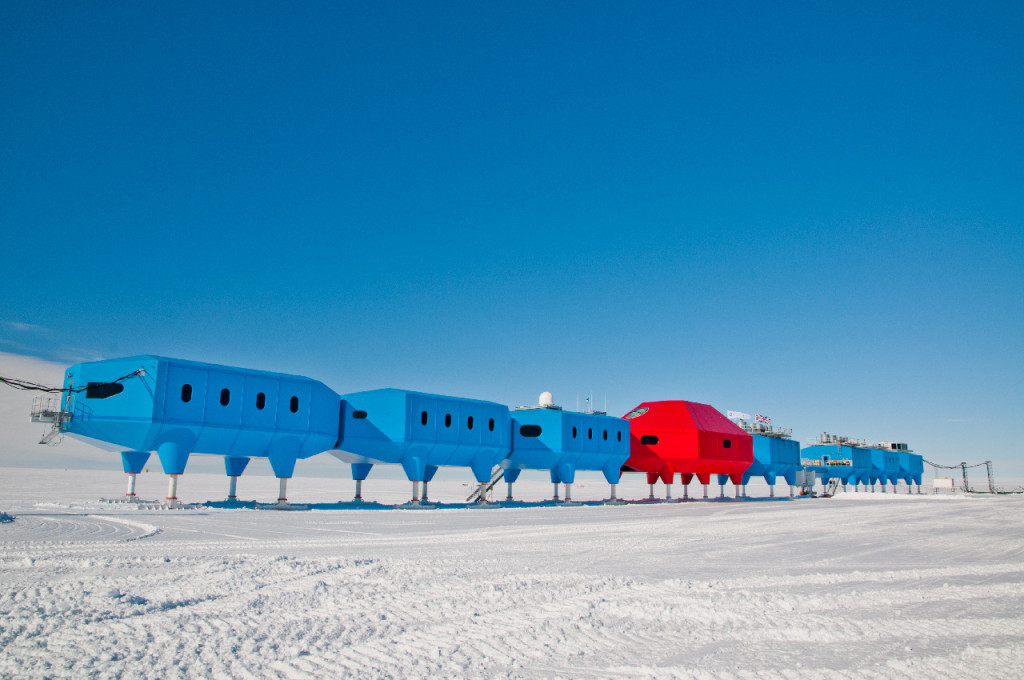
For the adventure-seekers, Halley VI offers a range of thrilling activities that allow you to make the most of your Antarctic adventure.
Snowmobiling
Exploring the Antarctic landscape on a snowmobile is an exhilarating experience. Guests can embark on guided snowmobile tours, racing across the pristine snowfields and taking in the breathtaking views.
Ice Climbing
The sheer ice formations of Antarctica present a unique opportunity for ice climbing. Guests with an adventurous spirit can try their hand at this challenging and rewarding activity under the guidance of experienced instructors.
Cross-Country Skiing
Cross-country skiing allows you to explore the frozen wilderness at your own pace. Halley VI provides guests with the equipment and guidance to enjoy this classic winter activity.
Ethical and Environmental Considerations
While guests at Halley VI have the chance to engage in a wide range of activities, they do so with the utmost consideration for ethical and environmental responsibility. Sustainable and responsible tourism practices are central to every guest experience at the station.
Minimizing Impact
All activities are carefully planned to minimize their impact on the Antarctic environment. This includes adhering to strict guidelines for waste management, waste disposal, and sustainable resource use.
Learning and Awareness
Guests are educated about preserving the Antarctic environment and adhering to ethical and environmental guidelines. This creates a sense of responsibility and awareness that ensures the fragile ecosystem remains undisturbed.
The Unforgettable Antarctic Adventure
In conclusion, the activities available to Halley VI Research Station guests offer a unique and unforgettable Antarctic adventure. Whether you’re exploring wildlife colonies, engaging in scientific research, or seeking thrills in the frozen wilderness, the experience is one of a kind. This journey allows you to immerse yourself in the pristine beauty of Antarctica but also fosters an understanding of the vital work being conducted in this remote region. With sustainability and environmental responsibility at the forefront, every activity is designed to leave minimal traces on the fragile Antarctic ecosystem, ensuring that the frozen wilderness remains unspoiled for future generations to experience and cherish.
The Cost of an Antarctic Adventure: Private Hire Pricing
Embarking on an Antarctic adventure is a dream for many, but turning that dream into reality involves more than just packing your bags. One of the critical aspects of planning such a journey is understanding the cost associated with private hire in this remote and pristine environment. An Antarctic adventure is undoubtedly a once-in-a-lifetime experience, but it comes with a price tag that reflects the unique challenges and exclusivity of the destination.
Factors Influencing Pricing
Several factors contribute to the cost of a private hire adventure to Antarctica. Understanding these factors helps travelers appreciate the value and uniqueness of their experience.
Location and Destination
Specific location and destination play a significant role in determining the cost. Some areas are more accessible, and the logistics of reaching and operating in remote regions can significantly impact the price.
Duration of Stay
The length of your stay also influences the cost. A longer visit typically comes with a higher price due to the extended logistics, accommodations, and support required.
Accommodations
The type of accommodations you choose can vary widely in cost. Standard rooms with shared facilities are more budget-friendly, while luxurious suites with private amenities come at a premium.
Activities and Experiences
The activities and experiences you desire can add to the overall cost. For example, engaging in scientific research or adventure sports may incur additional fees.
Group Size
The number of participants in your group can affect pricing. Smaller groups may pay more per person, while larger groups can sometimes secure discounts.
Understanding the Pricing Structure
Private hire pricing for Antarctic adventures typically includes several components.
Voyage Costs
This includes the expenses associated with transportation to and from Antarctica. Voyage costs can vary depending on the departure location, vessel type, and the itinerary.
Accommodation Costs
The type of accommodations you choose influences this part of the pricing. Luxury suites will cost more than standard cabins.
Activity Costs
Participating in specific activities or excursions may come with additional fees. These activities can range from wildlife encounters to adventure sports.
Expedition Staff
The cost may also include the fees for experienced expedition staff who accompany and guide guests throughout their journey. This staff plays a crucial role in ensuring the safety and enjoyment of your adventure.
The Price Range
Antarctic adventures vary in price, making it possible for many travelers to experience this unique destination. Here’s a general idea of what to expect:
Budget-Friendly Options
For travelers on a budget, there are more affordable Antarctic adventure options. These trips typically provide standard accommodations, fewer activities, and shorter durations. Prices for budget-friendly trips can start at around $5,000 to $10,000 per person.
Mid-Range Adventures
Mid-range options offer a balance between cost and comfort. These journeys may provide more comfortable accommodations and a broader range of activities. Prices for mid-range trips can range from $10,000 to $20,000 per person.
Luxury Expeditions
For those seeking the ultimate Antarctic experience, luxury expeditions provide top-tier accommodations, gourmet dining, and various activities. Prices for luxury trips can exceed $30,000 per person and go well beyond depending on the level of exclusivity and experiences.
The Value of an Antarctic Adventure
While the cost of an Antarctic adventure may seem steep, it’s essential to consider the incredible value of the experience. Travelers who embark on this journey are rewarded with a pristine and untouched wilderness, an opportunity to witness unique wildlife, and a deeper understanding of our planet’s challenges.
The Unique Value Proposition
An Antarctic adventure offers unparalleled experiences, making it a remarkable investment. Here are some of the aspects that contribute to the unique value proposition of a journey to this frozen wonderland:
A Pristine Wilderness
Antarctica remains one of the few places on Earth untouched by human civilization. The sheer remoteness and inaccessibility of this continent have preserved its pristine wilderness. Visitors have the rare privilege of witnessing an environment unaltered by human development, which is a profound and humbling experience.
Wildlife Encounters
Antarctica is teeming with unique and diverse wildlife, including penguins, seals, and various seabirds. Observing these creatures in their natural habitat offers insights into their adaptations to the region’s extreme conditions. The encounters with wildlife create lasting memories and a deep appreciation for the interconnectedness of life on Earth.
Scientific Discovery
Visitors to Antarctica often have the opportunity to engage with ongoing scientific research. This can include assisting with atmospheric studies, geomagnetic research, or biological surveys. Participating in these activities allows for a deeper understanding of the critical work being conducted on the continent.
Personal Growth and Perspective
An Antarctic adventure is not just a physical journey; it’s also a journey of personal growth and perspective. The isolation, the stark beauty of the landscape, and the closeness to nature offer a unique chance for self-reflection and a shift in one’s perspective on life, the environment, and the world.
A Legacy of Preservation
By participating in an Antarctic adventure, travelers contribute to preserving this fragile and vital ecosystem. The fees and investments made by visitors help fund conservation efforts, research, and sustainable tourism practices that aim to protect this extraordinary environment for future generations.
The Worth of an Antarctic Adventure
The cost of an Antarctic adventure may initially seem high, but the value it delivers is immeasurable. Exploring this pristine wilderness, encountering remarkable wildlife, and engaging in scientific endeavors offer a transformative and enriching experience. It’s a journey that transcends the boundaries of a traditional vacation, providing travelers with a deeper understanding of our planet’s natural processes, the significance of environmental conservation, and the sheer beauty of Earth’s last great wilderness.
In a world where travel experiences are increasingly homogenized and commercialized, an Antarctic adventure is a testament to the enduring spirit of exploration and the pursuit of knowledge. It’s an investment not just in a single journey but in the wonder of our planet and preserving a unique and irreplaceable environment. For those fortunate enough to undertake this adventure, the memories, knowledge, and perspective gained are worth every penny spent.
Beyond the Ice: The Importance of Antarctic Research
Antarctica, the world’s southernmost continent, is a place of extreme beauty where nature’s forces are fully displayed. But it’s not just a picturesque landscape. It’s a living laboratory for scientific research that holds answers to some of the most pressing questions about our planet’s past, present, and future. The importance of Antarctic research extends far beyond its icy confines, and one of the central hubs for this work is the Halley VI Research Station.
Scientific Research at Halley VI
Halley VI is not only a place for guests to experience the pristine beauty of Antarctica; it’s also a hub for cutting-edge scientific research. The station’s location on the Brunt Ice Shelf provides researchers with a front-row seat to some of the planet’s most critical processes.
Atmospheric and Climate Studies
One of the primary focuses of research at Halley VI is atmospheric and climate studies. The station has a wide range of instruments to monitor air quality, atmospheric composition, and weather patterns. This data is vital for understanding global climate change, weather forecasting, and tracking long-term trends in our planet’s atmosphere.
Seismological Studies
Halley VI is equipped with seismological instruments to monitor seismic activity in the region. Antarctica’s unique geological characteristics provide essential insights into plate tectonics, earthquake activity, and the Earth’s internal processes. These findings contribute to our understanding of geological forces worldwide.
Geomagnetic and Space Science
The station is involved in geomagnetic and space science research. Antarctica’s position in the Earth’s magnetic field and its isolation from electromagnetic interference make it an ideal location for studying the Earth’s magnetic properties, solar activity, and cosmic ray interactions. These studies shed light on the magnetic and cosmic phenomena that affect our planet.
Biological Research
Antarctica’s extreme conditions make it a natural laboratory for biological research. Scientists at Halley VI study the adaptations of life forms to the harsh Antarctic environment. This research has implications for understanding extremophiles, life forms that thrive in extreme conditions, and astrobiology, the study of life in space.
Monitoring Ice Dynamics
The Brunt Ice Shelf, where Halley VI is located, is a dynamic region. Scientists monitor the movement of ice, rifts, and calving events to understand ice dynamics, the interaction between ice and water, and the implications for rising sea levels.
How Private Expeditions Support Scientific Endeavors
While Halley VI is primarily a research station, it also plays a crucial role in private expeditions. The connection between private expeditions and scientific research is symbiotic, each using the other uniquely.
Funding for Research
Private expeditions generate revenue that can be reinvested in scientific research. Funds from these expeditions support the operation of research stations like Halley VI, providing essential resources for ongoing scientific studies.
Public Awareness
Private expeditions serve as conduits for bringing the importance of Antarctic research to the public. Travelers who experience Antarctica firsthand often become passionate advocates for environmental conservation and scientific discovery. They share their experiences and insights, raising awareness about the critical work being conducted in the region.
Collaboration and Resources
Private expeditions at research stations encourage collaboration between private travelers and scientists. Travelers can engage with ongoing research, contributing data, and assisting with studies. This collaboration extends the resources available for research projects.
Promoting Responsible Tourism
Private expeditions can be instrumental in promoting responsible tourism. Travelers who witness the pristine beauty of Antarctica are more likely to appreciate the importance of preserving this unique environment. They become ambassadors for sustainable and ethical tourism practices, which is critical for protecting the continent.
A Symbiotic Relationship
The relationship between private expeditions and scientific research at Halley VI is symbiotic. While private expeditions offer unique experiences to travelers, they also provide essential support for scientific endeavors. Antarctic research in this unique environment offers insights that extend far beyond the frozen wilderness, contributing to our understanding of global climate systems, geological forces, and the potential for life in extreme environments. The marriage of private expeditions and scientific research is a testament to the enduring value of exploration and the importance of understanding our planet’s most enigmatic and critical processes.
The Booking Process: Planning Your Antarctic Journey
Embarking on an Antarctic adventure is a dream for many, a once-in-a-lifetime experience that offers the opportunity to explore one of the world’s most pristine and enigmatic environments. However, planning a journey to a remote and inhospitable continent like Antarctica requires meticulous preparation. This article delves into the booking process, from arranging a private expedition to preparing for the adventure of a lifetime.
Booking a Private Expedition to Halley VI
Selecting the Right Expedition Provider
The journey begins with choosing a reputable expedition provider. Given the exclusivity and significance of the destination, selecting a provider with a track record of safety, environmental responsibility, and quality service is crucial. Be sure to research and compare providers to find one that aligns with your preferences and values.
Determining the Itinerary
Expeditions to Antarctica can vary widely in duration, activities, and destinations. Decide what kind of experience you’re seeking. Do you want to focus on wildlife encounters, scientific research, adventure activities, or a combination of these? Your preferences will dictate the itinerary you choose.
Dates and Availability
Antarctic expeditions typically have limited availability due to the continent’s brief and specific season. Plan your trip well in advance, as expedition spots can fill quickly. Be flexible with your travel dates to increase the likelihood of securing a spot on your preferred expedition.
Budget Considerations
The cost of Antarctic expeditions can vary significantly based on factors like the type of accommodations, duration, and activities. Create a budget that considers the expedition cost, travel to and from departure points, additional expenses like gear and insurance, and potential costs for optional activities.
Booking Your Spot
Once you’ve selected your provider, determined your itinerary, checked availability, and set a budget, it’s time to book your expedition. Ensure you read and understand the terms and conditions, including cancellation policies and payment schedules.
Preparing for the Antarctic Adventure
Health and Fitness
Antarctica’s harsh conditions demand a reasonable level of physical fitness. Consult your doctor before the trip to ensure your health and discuss any necessary vaccinations or health precautions. Being in good shape can make the adventure more enjoyable and comfortable.
Packing Essentials
Antarctica’s extreme cold requires careful packing. Most expedition providers offer detailed packing lists. Key items include insulated clothing, waterproof gear, sturdy boots, gloves, hats, and sunglasses. Remember essentials like sunscreen, lip balm, and a quality camera to capture the breathtaking landscapes and wildlife.
Travel Documents and Permits
Ensure you have all the necessary travel documents, including a valid passport. Your expedition provider will often assist with obtaining permits essential for visiting Antarctica. Be sure to have these in order well in advance of your departure.
Attending Pre-Departure Briefings
Expedition providers typically offer pre-departure briefings. Attend these sessions to gain important insights into what to expect during your journey. You’ll receive essential information about the itinerary, safety procedures, and environmental guidelines.
Physical and Mental Preparation
Antarctica can be an emotionally and physically challenging environment. Mentally prepare for the isolation and cold, and be ready to adapt to changing conditions. Equip yourself with the mindset that you’re embarking on a journey of a lifetime.
The Journey of a Lifetime
Planning an Antarctic adventure is meticulous, but the rewards are immeasurable. The booking process and preparations are critical for ensuring a safe, enjoyable, and responsible journey. With careful planning, attention to detail, and the right mindset, you’ll be well-equipped to experience this pristine continent’s unique beauty, wildlife, and scientific significance. Antarctica promises an adventure like no other, and your journey is an investment in unforgettable memories and a deeper understanding of our planet’s most enigmatic region.
Sustainable Tourism in Antarctica
Antarctica, a continent of extremes and extraordinary beauty, has fascinated explorers, scientists, and adventurers for centuries. In recent years, it has also captured the interest of tourists seeking to experience its pristine wilderness. However, the surge in tourism to this remote region has raised concerns about the impact of human activity on this delicate ecosystem. This article explores the concept of sustainable tourism in Antarctica, highlighting the efforts to balance the desire for exploration with the responsibility of preserving this unique environment.
Environmental Responsibility and Conservation Efforts
Protecting the Antarctic Environment
Antarctica is a region of immense ecological importance. It’s home to many wildlife, from penguins and seals to seabirds. The continent’s frigid waters teem with life, making it a vital component of the global ecosystem. It’s also a region with extreme climate conditions, where even the slightest human impact can have long-lasting consequences.
Environmental Guidelines and Regulation
The Antarctic Treaty System was established in 1959 to safeguard the Antarctic environment. It regulates human activity in the region and commits its signatories to environmental protection. Several key agreements have since emerged from this system, including the Protocol on Environmental Protection to the Antarctic Treaty, which designates Antarctica as a natural reserve dedicated to peace and science. These agreements outline strict guidelines for visitor conduct and environmental protection.
Waste Management
Responsible waste management is one of Antarctica’s most crucial aspects of sustainable tourism. Expedition providers and visitors are required to adhere to strict waste disposal procedures. This includes recycling, incineration, and the removal of all waste from the continent. Nothing can be left behind to disrupt the pristine landscape.
Minimal Impact on Wildlife
Interactions with wildlife are closely monitored and regulated. Visitors must keep a respectful distance from them to prevent disturbing or stressing animals. These guidelines help protect the animals and their natural behaviors.
Balancing Tourism with Preservation
Limited Access and Visitor Numbers
One of the fundamental principles of sustainable tourism in Antarctica is the restriction of visitor numbers. The remoteness and environmental sensitivity of the continent necessitate limited tourist activity. Only a select number of expedition providers are authorized to operate in the region, and they adhere to strict regulations to minimize their impact.
Strict Guidelines for Visitors
Visitors to Antarctica are provided with clear guidelines on conducting themselves during their stay. These guidelines include rules about waste disposal, wildlife interactions, and protecting protected sites. Expedition staff play a crucial role in educating visitors about these guidelines.
Responsible Tourism Practices
Responsible tourism practices are at the heart of sustainability in Antarctica. These practices include a commitment to low-impact activities, using energy sources, and promoting awareness among travelers. Expedition providers often employ environmental conservation experts to ensure visitors understand and respect the environment’s fragility.
Supporting Scientific Research
Sustainable tourism also plays a role in supporting scientific research. Visitors can actively engage with research projects and contribute to data collection. This collaboration helps advance scientific knowledge while raising awareness about the importance of research in the region.
A Balance of Preservation and Exploration
Sustainable tourism in Antarctica is a delicate balancing act. It’s a testament to the desire to explore and experience this unique environment while recognizing its profound responsibility to preserve it. As more people are drawn to this pristine continent, the commitment to environmental responsibility becomes increasingly vital. By adhering to strict regulations, raising awareness about the importance of conservation, and supporting research efforts, sustainable tourism ensures that future generations can continue to be inspired by Antarctica’s breathtaking beauty and scientific significance. It’s a model of preservation and exploration that stands as an example of responsible tourism worldwide.
In conclusion, Antarctica’s $150 million “Halley VI” research station isn’t just an architectural marvel; it represents a gateway to a world of scientific discovery, exploration, and unparalleled adventure. This unique facility, set against the backdrop of the frozen wilderness, serves as a testament to human ingenuity and our unquenchable curiosity about the mysteries of our planet.
From a brief history of the Halley research stations to the innovative design and mobility of Halley VI, we’ve delved into the heart of this remarkable station. It’s a place where groundbreaking research, unique experiences, and the pursuit of knowledge converge.
But the story continues after the research station itself. Private hire options allow individuals and organizations to immerse themselves in the Antarctic experience. Whether for scientific research, adventure, or an unforgettable getaway, Halley VI opens its doors to a select few who wish to share in the wonders of this pristine and awe-inspiring environment.
The cost of such an adventure is certainly a consideration. Still, viewing it as an investment in understanding our planet, preserving its delicate ecosystems, and forging memories that will last a lifetime is important. The journey to Antarctica is a blend of responsible tourism, environmental awareness, and exploration—a true testament to the enduring spirit of human endeavor and the relentless pursuit of knowledge.
As we reflect on the $150 million “Halley VI” research station in Antarctica, we find that it represents not only a hub of scientific exploration but also a symbol of our unwavering dedication to understanding and preserving the remarkable environments that make up our world. It stands as a testament to the power of human curiosity, our capacity for innovation, and the potential for responsible tourism to coexist harmoniously with the most pristine and fragile places on Earth.






